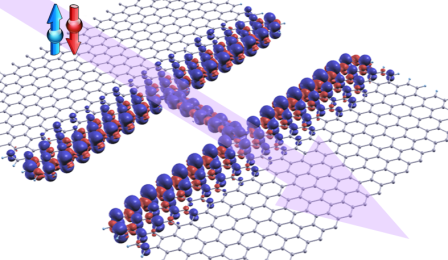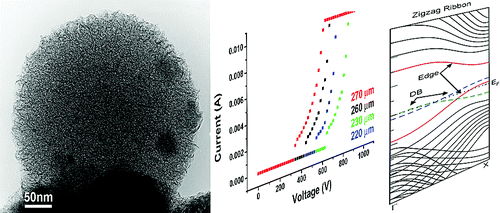Carbon based nanomaterials are promising for spintronic applications because the weak spin-orbit (SO) coupling and hyperfine interaction in carbon atoms entail exceptionally long spin diffusion lengths (~ 100μm) in carbon nanotubes (CNTs) and graphene. The exceptional electronic and transport features of C nanomaterials [Eur. Phys. J. B 72 1 (2009)] could be exploited to build multifunctional spintronic devices. However, a large spin diffusion length comes at the price of small SO coupling, which limits the possibility of manipulating electrons via an external applied field. The absence of an electronic bandgap in graphene further makes it impossible to switch off a graphene-based device. For this reason graphene nanoribbons and other 2D layered materials are also investigated.
In collaboration with Prof. G. Onida (University of Milano) and Prof. J.-C. Charlier (Universite’ catholique de Louvain) we have explored the quantum spin transport properties of C-chains, with even and odd number of atoms, connected to wide zigzag and armchair graphene nanoribbons (GNR) [ACS Nano 4(9) 5174 (2010)]. The latter system can be thought of as the smallest possible interconnects in C-based nanoelectronics and spintronics and illustrates the operating principle of C-based nanoelectronics and spintronics. Using the “open system” scheme we have shown that the various C-chains/GNR combinations allow one to create structures which are either semiconducting non-magnetic, metallic magnetic, or – most important – semiconducting magnetic. Such systems show tunable combinations of magnetic and transport properties, a fundamental feature for applications in spintronic devices.
The hexagonal phase of boron nitride (h-BN) is a wide-gap (~5.5 eV) insulating material, but the experimental group of Prof M. Terrones discovered that nanoscale particles of BN had protrusions which were not insulating. In collaboration with Prof. J.-C. Charlier we demonstrated that the observed zigzag nanoribbons of BN have a metallic character and can emit electrons at low turn-on voltages [Nano Lett. 8 (4), 1026-1032 (2008)]. This change is as radical as the transition from diamond to graphite/graphene in carbon: nanotubes and sheets made from BN always remain electrically insulating in their pristine form.
Publications:
- A. Dewandre, M. J. Verstraete, N. Grobert, Z. Zanolli,
Spectroscopic properties of few-layer tin chalcogenides
Journal of Physics: Materials, Focus issue on Women’s Perspectives in Materials Science: 2D Materials, J. Phys. Mater. 2, 044005 (2019) - M. Ersfeld, F. Volmer, P. M. M. C. de Melo, R. de Winter, M. Heithoff, Z. Zanolli, Ch. Stampfer, M. J. Verstraete, B. Beschoten,
Spin States Protected from Intrinsic Electron-Phonon-Coupling Reaching 100 ns Lifetime at Room Temperature in MoSe2 https://pubs.acs.org/doi/10.1021/acs.nanolett.9b01485 , https://arxiv.org/abs/1708.00228 - Z. Zanolli, C. Niu, G. Bihlmayer, Y. Mokrousov, P. Mavropoulos, M. J. Verstraete, and S. Blügel, Hybrid quantum anomalous Hall effect at graphene-oxide interfaces,
Phys. Rev. B 98, 155404 (2018) - S. Borghardt, F. Winkler, Z. Zanolli, M. J. Verstraete, J. Barthel, A. H. Tavabi, R. E. Dunin-Borkowski, B. Kardynal
Quantitative agreement between electron-optical phase images of WSe2 and simulations based on electrostatic potentials that include bonding effects,
Phys. Rev. Lett 118, 086101 (2017) - Z. Zanolli
Graphene-multiferroic interfaces for spintronics applications,
Scientific Reports, 6, 31346 (2016) - Z. Zanolli, Giovanni Onida, and J.-C. Charlier
Quantum spin transport in carbon chains
ACS Nano 4 (9), 5174–5180 (2010) - S.M.-M. Dubois, Z. Zanolli, X. Declerck, and J.-C. Charlier
Electronic properties and quantum transport in Graphene-based nanostructures.
Eur. Phys. J. B 72, 1-24 (2009) - M. Terrones, J.-C. Charlier, A. Gloter, E. Cruz-Silva, E. Terrés, Y.B. Li, A. Vinu, Z. Zanolli, J.M. Dominguez, H. Terrones, Y. Bando, and D. Golberg
Experimental and theoretical studies suggesting the possibility of metallic Boron Nitride edges in porous nanourchins.
Nano Lett. 8 (4), 1026-1032 (2008)





